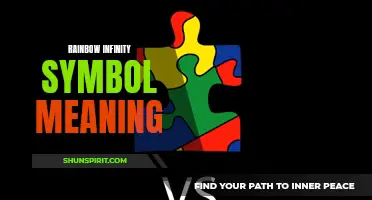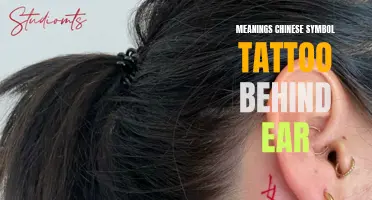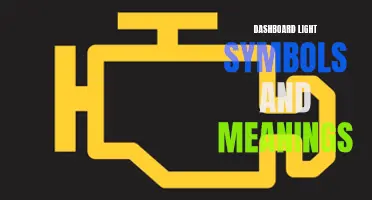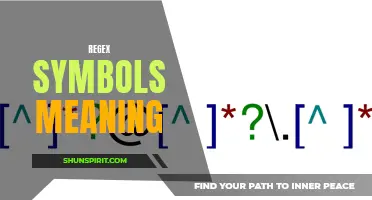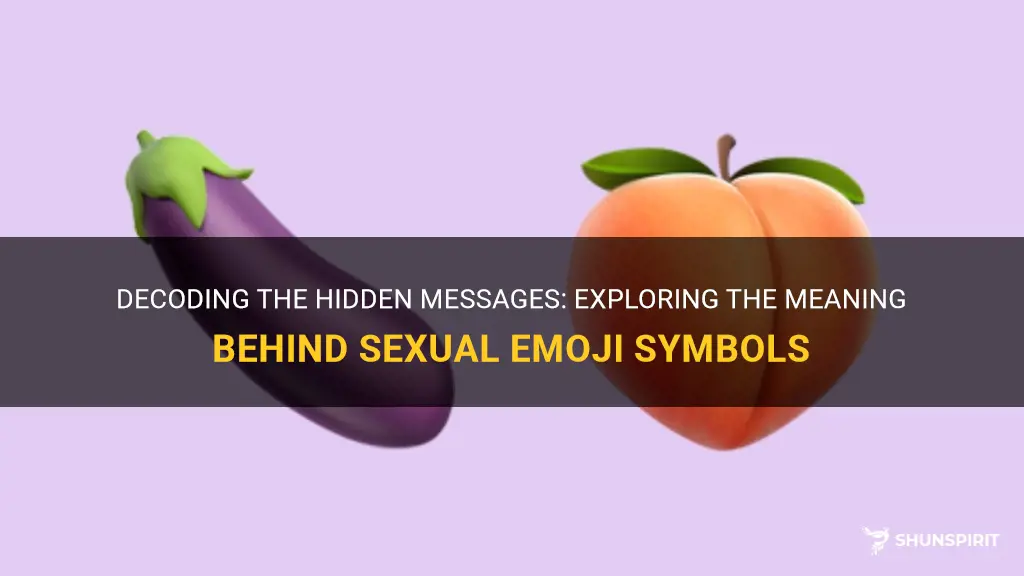
In today's digital age, communication has become more dynamic and expressive than ever before. Emojis, small pictorial symbols that convey emotions and ideas, have become an integral part of our everyday conversations. While most emojis are used innocently to add flair and emotion to our texts, there is a subset of them that carry a more suggestive meaning - the sexual emoji symbols. These naughty little icons are imbued with hidden meanings, innuendos, and even bold declarations of desire. Join me as we dive into the world of sexual emoji symbols and explore their various meanings and contexts.
What You'll Learn
- What are some commonly used sexual emoji symbols and their meanings?
- Are there any universally accepted meanings for sexual emoji symbols, or do they vary depending on cultural context?
- How have sexual emoji symbols evolved over time, and are there any new symbols that have emerged in recent years?
- Do different platforms or devices show sexual emoji symbols differently, and does this affect their perceived meaning?
- Are there any risks or negative consequences associated with using sexual emoji symbols in digital communication?

What are some commonly used sexual emoji symbols and their meanings?
Sexual emoji symbols have become increasingly popular on social media and messaging platforms. These symbols, often referred to as "flirtmoji" or "sexy emoji," can be used to express sexual desire, flirtation, or suggestiveness. While the intention behind using these symbols may vary, it is important to understand their meanings to avoid any misunderstandings or unintended consequences.
- Eggplant 🍆: The eggplant emoji is one of the most commonly used sexual symbols. It is often used to represent a penis due to its shape. When used in a sexual context, this emoji implies flirtation, seduction, or sexual desire.
- Peach 🍑: The peach emoji is often associated with the female buttocks. It is used to represent a shapely and attractive derriere. When used in a sexual context, this emoji can imply a desire for intimate or suggestive activities.
- Water droplets 💦: This emoji is often used to represent bodily fluids, particularly ejaculation. It can be an indirect way to imply sexual activities or suggestiveness. However, it can also be used in non-sexual contexts to indicate enthusiasm or excitement.
- Tongue 👅: The tongue emoji is commonly used to suggest oral activities or to symbolize a flirtatious, seductive gesture. It can be used in a playful or suggestive manner to indicate interest or desire.
- Fire 🔥: The fire emoji is used to convey intensity, attractiveness, or sexiness. It can imply a strong physical or sexual attraction towards someone. It is often used to comment on someone’s appearance or to express desire.
- Love hotel 🏩: This emoji depicts a hotel building with a heart symbol, representing a love hotel or a place for romantic encounters. It can be used to suggest a desire for intimacy, romantic activities, or late-night adventures.
- Lips 👄: The lips emoji is often used to represent a kiss, whether it is a real or virtual one. It can be used to indicate a desire for physical affection or to suggest a flirtatious or romantic intention.
It is crucial to note that the interpretation of these symbols can vary depending on the context, cultural background, and individual perspective. The intention behind using these symbols should always be clear and consensual to ensure that they are understood and received appropriately. Additionally, it is important to consider the implications of these symbols and use them responsibly, respecting the comfort and boundaries of others.
Floral Messages: Exploring the Symbolic Meaning of Flowers in the Bible
You may want to see also

Are there any universally accepted meanings for sexual emoji symbols, or do they vary depending on cultural context?
Sexual emoji symbols have become increasingly prevalent in digital communication in recent years. While these symbols may seem straightforward, their meanings can vary greatly depending on cultural context and personal interpretation.
In Western cultures, there are some generally accepted meanings for sexual emoji symbols. For example, the eggplant emoji is often used to represent a phallus, while the peach emoji is commonly associated with a buttocks or a posterior. Similarly, the water droplets emoji may be interpreted as representing sexual fluids. These symbols are often used to convey flirtation or suggestiveness in a playful manner.
However, it is important to note that these interpretations are not universal. Different cultures and individuals may have different associations and meanings for these symbols. In some cultures, for example, the eggplant may not be associated with the same phallic connotation as it is in Western cultures. Likewise, the peach emoji may have different connotations or meanings in different cultural contexts.
Furthermore, personal preferences and interpretations of these symbols can also vary greatly. What one person may see as a flirtatious or suggestive symbol, another person may interpret as something entirely different. This subjectivity highlights the importance of considering the intended audience and context when using these symbols in digital communication.
In addition to cultural and personal variations, the context in which these symbols are used can also greatly impact their meaning. For example, using a sexual emoji symbol within a close-knit group of friends may be seen as playful and harmless. However, using the same symbol in a professional or formal setting may be considered inappropriate or unprofessional.
Overall, while there are some generally accepted meanings for sexual emoji symbols in Western cultures, their meanings can vary greatly depending on cultural context and personal interpretation. It is important to be aware of these variations and to consider the intended audience and context when using these symbols in digital communication.
Decoding the Symbols of Zoosk: What They Mean and How to Use Them
You may want to see also

How have sexual emoji symbols evolved over time, and are there any new symbols that have emerged in recent years?
Emoji symbols have become an increasingly popular way for people to communicate and express themselves, and sexual emoji symbols are no exception. Over time, these symbols have evolved and changed in response to cultural shifts and emerging trends. In recent years, several new symbols have emerged, adding to the ever-expanding repertoire of sexual emoji options.
When emoji symbols were first introduced in 1997 by Shigetaka Kurita, a Japanese designer, they were primarily basic icons representing emotions and objects. There were no explicit sexual emoji symbols in the initial collection. However, as internet culture developed and communication became increasingly digital, demand grew for more diverse and nuanced emoji options.
One of the earliest sexual emoji symbols to emerge was the "eggplant" emoji. The eggplant is widely recognized as a symbol for phallic representation, and its use in a sexual context quickly became prevalent. This emoji, along with other fruit and vegetable options like the peach and banana, became popular euphemisms for sexual innuendos.
As social media and messaging apps incorporated emoji into their platforms, users began to find creative ways to convey sexual messages without using explicit language. Emoji symbols that suggested more explicit content soon emerged. For example, the "peach" emoji began to be used to represent buttocks, and the "water droplets" emoji came to signify sexual fluid or arousal.
In recent years, new sexual emoji symbols have appeared, reflecting changing cultural attitudes towards sexuality and a desire for more inclusivity. One notable addition is the "eggplant and sweat droplets" emoji, which combines the symbolism of the eggplant with the implication of sexual activity or desire through the sweat droplets.
Another new symbol that has emerged is the "stuffed underpants" emoji. This emoji, featuring a pair of underwear filled with a bulge, is often used to represent male arousal or a sexual proposition. Its introduction underscores the growing recognition of diverse sexual experiences and preferences.
Additionally, there are regional and cultural variations in sexual emoji symbols. In some countries, certain symbols may have different connotations or be used more frequently than others. For example, the "aubergine" emoji, the European equivalent of the eggplant emoji, is often used in a sexual context. Similarly, the "sweat drops" emoji, which conveys sexual desire in Western cultures, may be interpreted differently in other regions.
It is worth noting that while sexual emoji symbols can add a playful and humorous element to digital communication, they can also be misinterpreted or even offensive. As with all forms of communication, it is essential to consider the context in which these symbols are used and to be mindful of the potential impact they may have on others.
In conclusion, sexual emoji symbols have evolved over time to reflect changing cultural attitudes, trends, and digital communication needs. Alongside classic symbols like the eggplant and peach, new symbols like the stuffed underpants emoji have emerged, providing users with a broader range of options to express themselves sexually. It is important to remember that context and understanding vary, and these symbols should be used respectfully and responsibly.
Unlocking the Meaning Behind Indian Symbols: A Journey Into the Heart of Ancient Indian Culture
You may want to see also

Do different platforms or devices show sexual emoji symbols differently, and does this affect their perceived meaning?
In today's digital world, communication has become increasingly reliant on symbols, especially emojis. These small digital images have become a language of their own, allowing people to convey emotions, ideas, and even sexual innuendos. However, there is a growing concern about the inconsistency in how these emojis are displayed across different platforms and devices and how this affects their perceived meaning.
Emojis have become an integral part of our daily conversations, and their meanings have become widely understood. However, when it comes to sexual emojis, the differences in their depiction on various platforms can lead to confusion or even miscommunication. For example, a simple eggplant emoji, which is widely known to represent a phallic symbol, may not always be interpreted the same way on different platforms.
The issue of inconsistency arises because each platform or device has its own set of standards for displaying emojis. The Unicode Consortium, a non-profit organization responsible for standardizing these symbols, provides a universal code for each emoji. However, individual developers have the freedom to interpret these codes and design their own version of each emoji. As a result, emojis can vary significantly in appearance, color, and even meaning across platforms.
One of the most notable examples of this is the peach emoji. Originally created to represent the fruit, it quickly gained a sexual connotation due to its similarity to a buttock. However, the peach emoji's popularity has led to different interpretations of its meaning on different platforms. Some platforms depict it as a realistic-looking peach, while others show a more stylized version with a cleft in the center. This inconsistency can lead to confusion or misinterpretation, especially when used in a sexual context.
Moreover, the color of emojis can also vary across platforms, further complicating their perceived meaning. For example, a red heart emoji may represent love and passion on one platform, while a blue heart emoji may represent friendship or loyalty on another. These variations in color can significantly impact the intended meaning of an emoji, causing confusion or even misinterpretation.
To address this issue, some platforms have started to adopt standardized designs for emojis, following the guidelines set by the Unicode Consortium more closely. This move aims to ensure that emojis retain their intended meaning regardless of the platform or device used. However, achieving complete consistency across all platforms remains a challenge due to the fragmented nature of the digital world.
In conclusion, the inconsistency in how sexual emojis are displayed across different platforms and devices can affect their perceived meaning. The variations in appearance, color, and interpretation can lead to confusion or even miscommunication. As emojis continue to play a significant role in digital communication, it is crucial for developers and platforms to work towards a more uniform depiction of these symbols to avoid any unintended consequences.
Exploring the Deeper Meaning Behind the Symbol of Gratitude
You may want to see also

Are there any risks or negative consequences associated with using sexual emoji symbols in digital communication?
Using sexual emoji symbols in digital communication has become increasingly popular in recent years. These symbols, which can range from subtle innuendos to explicit imagery, are often used to add humor or spice to conversations. While many people find them lighthearted and fun, there are risks and negative consequences associated with their use.
One of the main risks is misinterpretation. Emoji symbols are ambiguous by nature, and their meaning can vary depending on the context and the individuals involved in the conversation. What may be intended as a harmless joke can easily be misread as a proposition or an offensive gesture. This can lead to awkward or uncomfortable situations, particularly if the sender and recipient have different interpretations of the symbols being used.
Another risk is the potential for harassment or objectification. Using sexual emoji symbols can be seen as a form of sexualization or objectification of the person on the receiving end. This can be especially problematic if the recipient is uncomfortable with such behavior or if the sender is not fully aware of the implications of their actions. In some cases, the use of sexual emoji symbols can even be considered a form of online harassment, resulting in negative emotional consequences for the recipient.
Furthermore, the use of sexual emoji symbols can perpetuate harmful stereotypes and reinforce negative attitudes towards sexuality. By reducing complex sexual experiences and emotions to simple symbols, we risk oversimplifying and trivializing the topic of sexuality. This can contribute to a lack of understanding and empathy towards others' experiences and perpetuate harmful norms and expectations surrounding sex.
In addition to these risks, there are potential negative consequences associated with using sexual emoji symbols in professional or formal contexts. While they may be appropriate and well-received in casual conversations between friends or romantic partners, using such symbols in the workplace or in professional emails can be seen as unprofessional or even offensive. This can have serious consequences for one's reputation and career prospects.
Overall, while the use of sexual emoji symbols can seem harmless and fun, it is important to consider the potential risks and negative consequences. It is vital to communicate with respect and consent, ensuring that all parties involved are comfortable with the language and symbols being used. Additionally, it is crucial to be aware of the context and the power dynamics at play, particularly in professional or formal settings. By being mindful of these considerations, we can promote healthier and more respectful digital communication practices.
Understanding the Symbolism and Meanings Behind LGBT Symbols
You may want to see also
Frequently asked questions
The peach emoji is often used in a sexual context to represent a person's buttocks. It can be used to suggest a playful or suggestive message, particularly when used alongside other suggestive emojis or in a flirtatious conversation.
The eggplant emoji is commonly used to symbolize a phallus or penis in a sexual context. It is often used to represent sexual desire or suggestively in conversations relating to intimate or explicit content.
The water droplets emoji, when used in a sexual context, typically represents sexual fluids or arousal. It can be used to imply sexual excitement or an invitation to engage in sexual activities.
In a sexual context, the fire emoji is often used to represent intense passion, attraction, or strong sexual desire. It can be used to convey excitement or enthusiasm in a flirtatious conversation.
The two pink hearts emoji is often used to symbolize love or affection in a sexual context. It can suggest intense romantic or sexual feelings between two people and is commonly used in intimate or flirtatious conversations.


